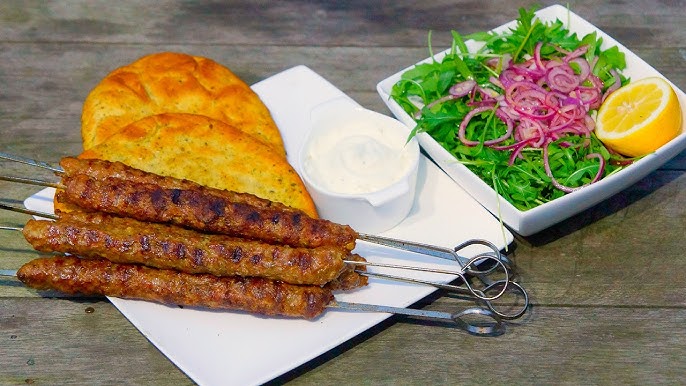Kebab Recipe: Kebabs are a timeless culinary delight that span across cultures, continents, and centuries. At their core, kebabs are simply pieces of meat (and sometimes vegetables) that are seasoned, skewered, and cooked—most often over an open flame. Originating from the Middle East, the concept of kebabs quickly traveled through South Asia, the Mediterranean, and even into parts of Europe and the Americas, evolving in flavor and technique as it went.
In places like Turkey, the term “kebab” can refer to dozens of different dishes, from the vertical rotisserie doner to the well-known shish kebabs. In India and Pakistan, spicy seekh kebabs and tender reshmi kebabs take center stage. No matter the type, the allure of juicy, flavorful meat and smoky aroma is universally irresistible.
Popular Types of Kebabs Around the World
Let’s take a quick flavor tour:
- Shish Kebab (Middle East): Cubes of marinated meat grilled on skewers.
- Seekh Kebab (South Asia): Minced meat mixed with spices and herbs, shaped onto skewers.
- Doner Kebab (Turkey): Thin slices of meat shaved from a rotating spit.
- Kofta Kebab (Mediterranean): Spiced meatballs grilled or baked, often served with flatbread.
- Yakitori (Japan): Skewered and grilled chicken parts, seasoned with tare or salt.
Ingredients You’ll Need
For the Meat Marinade
The beauty of kebabs lies in the marinade—this is where the magic begins. A good marinade infuses the meat with flavor and helps tenderize it for that perfect bite.
Basic Marinade Ingredients:
- 500g of your preferred meat (chicken, lamb, or beef)
- 4 tablespoons of plain yogurt
- 2 tablespoons of lemon juice
- 1 tablespoon of olive oil
- 1 teaspoon ground cumin
- 1 teaspoon paprika
- 1 teaspoon ground coriander
- 1/2 teaspoon turmeric
- Salt and pepper to taste
- 3 cloves of garlic, minced
- 1-inch piece of ginger, grated
The yogurt and lemon juice help break down the meat fibers, making it tender, while the spices provide that deep, smoky, and rich flavor profile typical of kebabs.
Optional Vegetables and Add-ons
If you like a bit of color and crunch on your skewers, add these:
- Red and green bell peppers
- Cherry tomatoes
- Onions (cut into chunks)
- Mushrooms
- Zucchini slices
Thread them alternately between the meat pieces on the skewer for added flavor and visual appeal.
Choosing the Right Meat
Lamb, Beef, Chicken – Which One’s Best?
Each meat option brings its own personality to the dish:
- Lamb: Rich and earthy, lamb is the traditional choice in many Middle Eastern and Mediterranean kebabs. It pairs beautifully with bold spices and is best cooked to medium for a tender texture.
- Beef: A great alternative for heartier kebabs. Choose cuts like sirloin or ribeye for grilling. Ensure it’s not too lean to keep the meat juicy.
- Chicken: Popular for its versatility and quicker cook time. Use boneless thighs for the juiciest results. Breasts can work too but tend to dry out quicker if overcooked.
Vegetarian Alternatives
You don’t need to be a meat-eater to enjoy kebabs. Here are some excellent vegetarian options:
- Paneer (Indian cheese): Firm and perfect for skewering; soaks up marinades beautifully.
- Tofu: Use extra-firm tofu and press it well to remove moisture before marinating.
- Vegetable skewers: Combine mushrooms, bell peppers, cherry tomatoes, and zucchini for a healthy, colorful kebab.
- Seitan or Tempeh: High-protein meat substitutes that hold up well to grilling and intense spices.
Preparing the Marinade
Key Spices and Their Role
Let’s get real—the spices make or break your kebab. Here’s what each brings to the table:
- Cumin: Earthy and slightly smoky, essential in most kebab recipes.
- Coriander: Citrusy and nutty, a perfect partner to cumin.
- Paprika: Adds color and a sweet-smoky layer of flavor.
- Turmeric: Earthy with a golden hue, it boosts visual appeal and flavor.
- Chili Powder: For those who like it hot—adjust based on your heat preference.
Combine these with garlic and ginger to build a flavor base that seeps deep into the meat.
Marination Time and Tips
For best results, marinate your meat for at least 4 hours, though overnight is ideal. This allows the flavors to penetrate deeply and ensures the meat becomes more tender and flavorful.
Marination Tips:
- Use a zip-lock bag or airtight container to avoid drying out.
- Always marinate in the refrigerator.
- Don’t reuse leftover marinade unless it’s cooked—it contains raw meat juices.
- If you’re short on time, even 1 hour can work with chicken, but you’ll sacrifice some depth of flavor.
Cooking Methods
Grilling Kebabs on Skewers
If you have access to a grill or BBQ, this is the gold standard. The high heat caramelizes the marinade, creating delicious charred edges.
Steps:
- Preheat your grill to medium-high.
- Thread marinated meat (and veggies, if using) onto metal or soaked wooden skewers.
- Place skewers on the grill, turning every 2-3 minutes.
- Cook for about 10–12 minutes until the meat is fully cooked and has a nice char.
Pro Tip: Keep a spray bottle of water nearby to control flare-ups from dripping fat.
Oven-Baked Kebabs
No grill? No problem. Your oven can deliver juicy kebabs too.
Steps:
- Preheat the oven to 220°C (430°F).
- Line a baking tray with foil and place a rack on top.
- Arrange the skewers on the rack for even cooking.
- Bake for 20–25 minutes, turning once halfway.
- Broil for the last 2–3 minutes for extra char.
This method is great for batch cooking and weatherproof kebab-making.
Pan-Fried Kebabs
Perfect for weeknight dinners when you’re short on time but still crave something smoky.
Steps:
- Heat a heavy skillet or cast iron pan with a splash of oil.
- Add skewered kebabs or form meat into patties for ease.
- Cook on medium heat for 6–8 minutes per side until cooked through.
This method delivers intense flavor and a satisfying crust on the outside of your kebabs.
Serving Suggestions
Classic Accompaniments
What’s a kebab without its delicious sides? To complete your kebab experience, consider pairing it with traditional accompaniments that balance the spices and textures of the dish:
- Flatbreads: Soft naan, pita, or lavash are ideal for wrapping around kebabs or scooping up juicy bites.
- Chutneys & Sauces: A cooling yogurt-based raita, mint chutney, garlic sauce, or tahini add contrast and creaminess.
- Pickled Onions: Thinly sliced red onions pickled in vinegar and salt cut through the richness of the meat.
- Fresh Salads: A simple cucumber and tomato salad or tabbouleh brings a refreshing crunch to your plate.
- Rice or Couscous: Fluffy, lightly spiced rice or couscous makes a great base for kebabs, soaking up juices and sauces.
Mix and match these sides depending on the regional variation of kebab you’re going for—Mediterranean, Middle Eastern, or South Asian.
Plating Like a Pro
Presentation matters. Serve kebabs over a bed of salad or rice, with a drizzle of sauce across the top and a lemon wedge on the side. Skewers can be served as-is for a rustic vibe or slid off onto a plate for a more polished appearance.
Use colorful vegetables and herbs for garnish—think chopped cilantro, parsley, or thinly sliced radishes. It’s the kind of plating that will make everyone reach for their phones before digging in!
Kebab Variations to Try
Seekh Kebab
Seekh kebabs are a spicy South Asian favorite made with minced meat, finely chopped onions, green chilies, coriander, and a blend of aromatic spices. The mixture is shaped around metal skewers and grilled or baked until golden and slightly crisp.
Perfect as a starter or wrapped in paratha with onions and chutney for a street-style roll, these are incredibly satisfying.
Shish Kebab
A staple of Turkish and Middle Eastern cuisine, shish kebabs consist of marinated cubes of lamb or chicken grilled on skewers. They’re simple yet incredibly flavorful, especially when the marinade is allowed to do its magic overnight.
Pair them with a light pilaf and grilled vegetables for an authentic meal.
Chapli Kebab
These kebabs hail from Pakistan and Afghanistan and are shaped like patties instead of skewered. Made from ground meat, crushed pomegranate seeds, and spices, they’re pan-fried until crispy on the outside and tender inside.
They’re often served with naan and chutney and are particularly popular for lunch or dinner during Ramadan.
Tips for Perfect Kebabs Every Time
Use Fat Wisely
Lean meat can dry out quickly on the grill. Whether you’re using minced meat for seekh kebabs or chunks for shish, ensure there’s enough fat to keep things juicy. If using lean cuts, add a bit of oil or yogurt to the marinade to compensate.
Preheat and Monitor Heat
Whether you’re grilling or baking, preheating is key. It ensures your kebabs start cooking the moment they hit the heat, sealing in juices. Also, monitor the flame or oven temperature closely—too hot and the outside will burn before the inside is cooked; too low and they’ll dry out.
Don’t Overcrowd the Skewers
Leave a little space between pieces so that heat can circulate evenly. This helps achieve a consistent char and prevents steaming.
Rest Before Serving
Let your kebabs rest for 5–10 minutes after cooking. This allows the juices to redistribute, making each bite moist and flavorful.
Common Mistakes to Avoid
Skipping the Marination
Don’t rush the marination process. It’s the step that makes or breaks a good kebab. The acids in yogurt or lemon juice help tenderize the meat while the spices build flavor.
Uneven Cutting
If your meat or vegetables are cut into uneven chunks, they’ll cook at different rates. This can lead to some parts being undercooked while others burn. Uniformity is crucial for consistent cooking.
Using Dry Wooden Skewers
Always soak wooden skewers in water for at least 30 minutes before grilling. This prevents them from catching fire. Better yet, invest in reusable metal skewers—they’re sturdy, safe, and eco-friendly.
Overcooking
Especially with chicken and lean beef, overcooking is a real threat. Always cook to the proper internal temperature and watch closely in the final minutes.
Storing and Reheating Kebabs
How to Store Leftover Kebabs
If you’ve made more kebabs than you can eat in one sitting—lucky you! Proper storage will keep your kebabs fresh for future enjoyment. Here’s how to do it right:
- Refrigeration: Place cooled kebabs in an airtight container and store them in the fridge. They’ll stay good for up to 3–4 days.
- Freezing: Want to keep them longer? Wrap individual skewers or portions in plastic wrap or foil, then place them in a freezer-safe bag or container. They’ll last for up to 2–3 months without losing much flavor.
- Separate Sauces and Sides: Store chutneys, sauces, and salads separately to maintain freshness and avoid sogginess.
Reheating Tips
Reheating kebabs the right way is key to preserving their texture and taste.
- Oven: Preheat to 180°C (350°F), wrap kebabs in foil, and warm for 10–15 minutes.
- Stovetop: Use a non-stick pan with a few drops of oil, cover with a lid, and reheat on low to medium heat for 5–7 minutes, turning occasionally.
- Microwave: Not ideal for retaining texture, but in a pinch, heat in 30-second intervals until warmed through.
Add a splash of water or broth while reheating to help keep the meat moist.
Healthier Kebab Options
Low-Calorie Tweaks
Craving kebabs but trying to eat light? No worries—you can easily tweak the traditional recipe to make it more diet-friendly.
- Use lean meats: Skinless chicken breast or turkey can significantly cut down fat content.
- Skip the oil: Use yogurt-based marinades without extra oil.
- Grill, don’t fry: Cooking on a grill or in the oven allows fat to drip away, reducing calorie load.
- Bulk with veggies: Add more peppers, onions, and zucchini to your skewers for volume and nutrients.
Plant-Based Power
Plant-based kebabs can be just as satisfying with the right marinade and texture. Use firm tofu, tempeh, or even mushrooms as your protein base. Amp up flavor with robust spice blends and grill until crisp.
- Bonus Tip: Smoked paprika and liquid smoke can mimic that chargrilled meat flavor without any meat at all!
FAQs about Kebab Recipe
1. Can I make kebabs without skewers?
Absolutely! You can form the marinated meat into patties or logs and cook them in a pan or oven.
3. What is the best cut of meat for kebabs?
For best flavor, marinate for at least 4 hours. Overnight marination gives even better results.
3. What is the best cut of meat for kebabs?
For beef or lamb, use tender cuts like sirloin or leg. For chicken, boneless thighs are juicier than breasts.
4. Can I prepare kebabs ahead of time?
Yes, you can marinate and skewer them up to a day in advance. Store them in the fridge until ready to cook.
5. What sauces go well with kebabs?
Try yogurt-based raita, mint chutney, garlic sauce, tahini, or even spicy harissa for a flavorful punch.
Conclusion
Kebabs are one of those dishes that never go out of style. Whether you’re throwing a backyard BBQ, prepping a weeknight dinner, or simply craving something smoky and spicy, a well-made kebab hits all the right notes. With endless variations, from the classic shish to the spicy seekh or even veggie-packed skewers, kebabs offer something for everyone.
Take your time with the marinade, experiment with spices, and try different meats and cooking methods until you find your perfect combo. With this step-by-step guide, you’re now fully equipped to create restaurant-worthy kebabs right at home—no takeout menu required.



